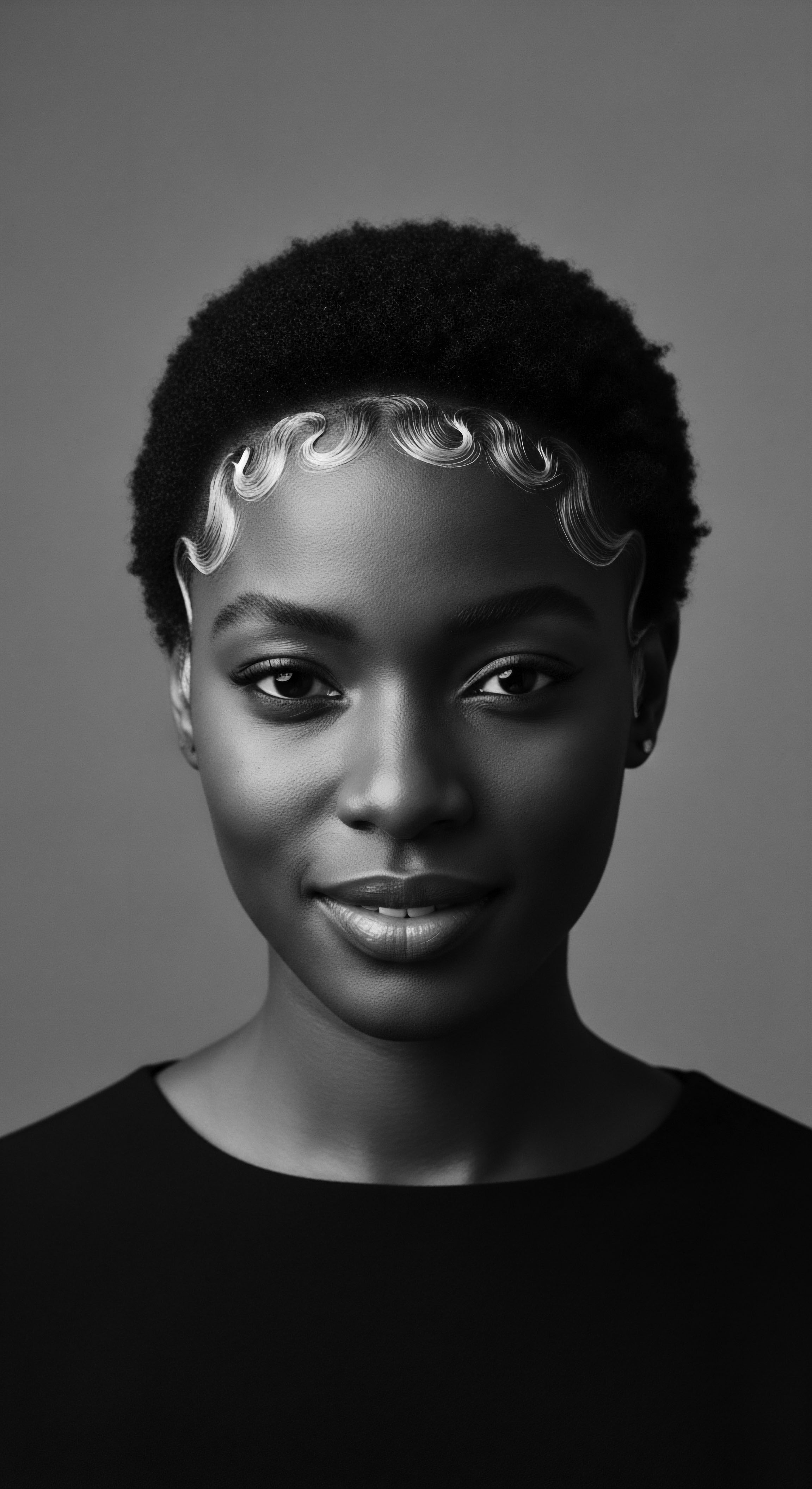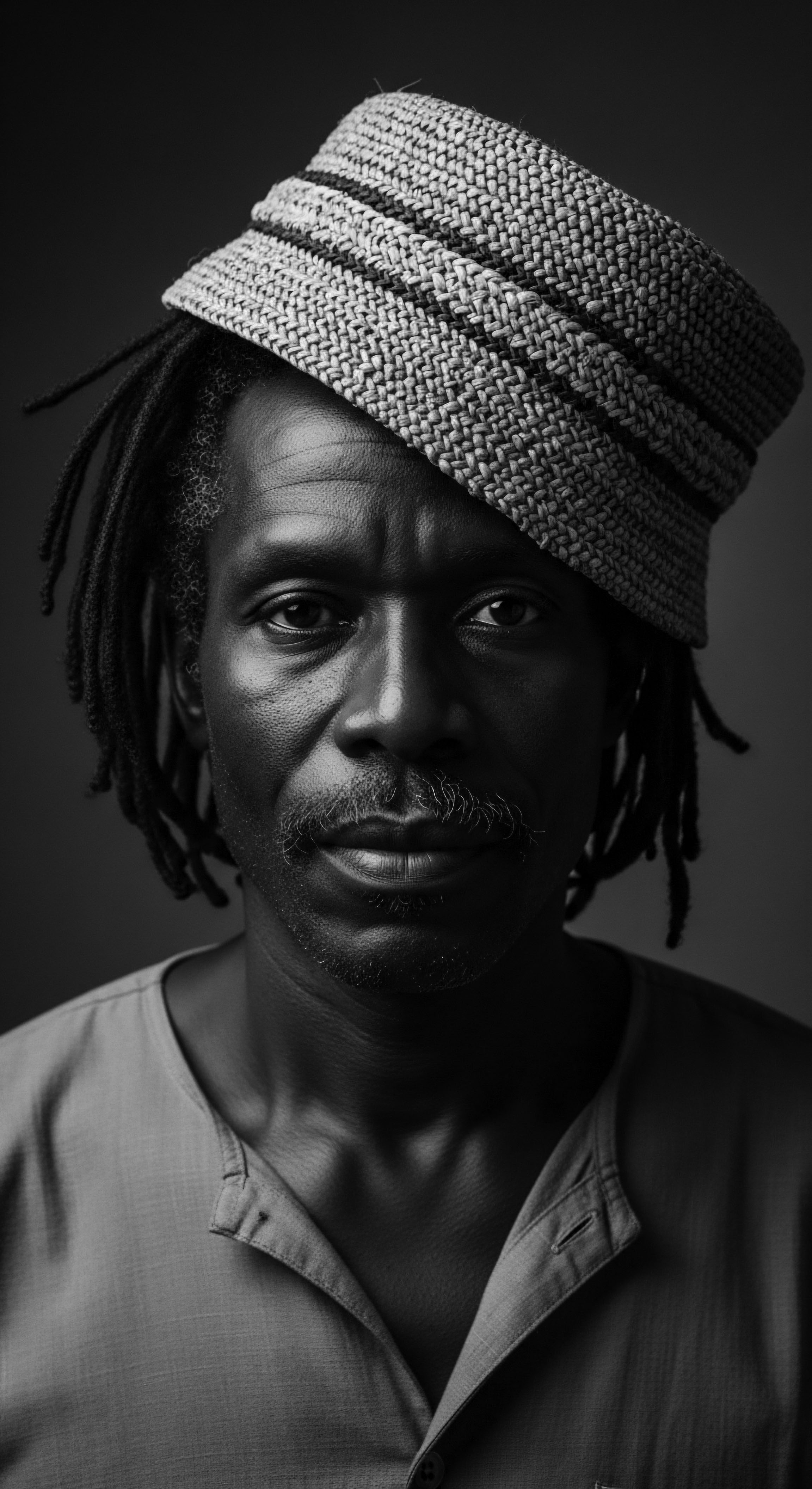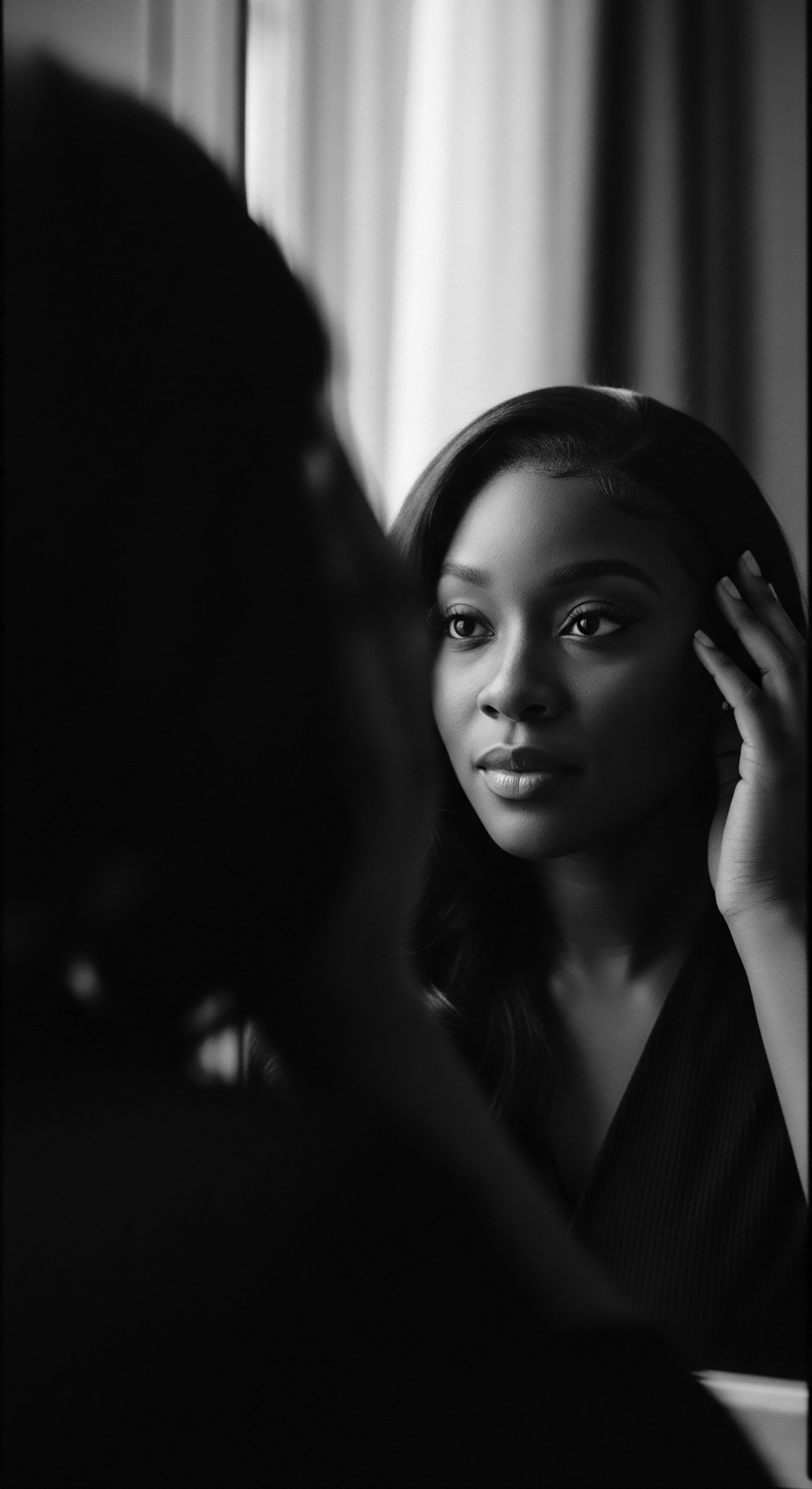
Roots
To truly perceive a strand of textured hair, one must listen to its ancestral song, recognizing it as a vibrant archive, a living testament to generations past. Each coil, each kink, each wave holds not merely genetic code, but also the whispered wisdom of forebears. When we speak of traditional oiling methods, we speak not of a superficial beauty treatment, but of rituals deeply etched into the communal spirit and personal practice of Black and mixed-race communities. These methods are foundational to understanding the very structure of textured hair, viewed through a lens of inherited knowledge and scientific validation.

What Constitutes a Textured Hair Strand?
The anatomy of textured hair, distinct in its helical architecture, presents unique considerations for care. Unlike straight hair, which typically possesses a round cross-section, coily and curly strands often display an elliptical or flattened shape. This structural variation contributes to fewer cuticle layers, rendering these strands more susceptible to moisture loss and external stressors.
The bends and twists along the hair shaft create natural points of elevation for the cuticle, making it less likely for natural sebum, the scalp’s protective oil, to travel effectively down the entire length of the strand. This inherent propensity for dryness is a core reason why ancestral communities intuitively turned to external oil applications, acknowledging the hair’s elemental needs long before modern microscopy.
The very nomenclature used to describe textured hair today, while often scientific, carries echoes of cultural recognition. We classify curls, coils, and kinks not just by their geometric patterns, but by their response to environmental factors and product application, a discernment honed over centuries by practitioners of hair care who lived by touch and observation. Traditional oiling methods, thus, become a biological necessity and a cultural imperative, directly addressing the hair’s need for lubrication and fortification against the elements.
Each coil of textured hair whispers a story of survival and beauty, its unique shape guiding ancestral care practices.

Ancient Echoes in Hair’s Life Cycle
Hair growth cycles, universal in their biological rhythm, found tailored support within heritage oiling traditions. The anagen phase, where hair actively grows, benefits from a healthy scalp environment, a condition directly addressed by ancient oiling. By gently massaging oils into the scalp, practitioners stimulated circulation, delivering vital nutrients to the hair follicles.
The catagen and telogen phases, periods of transition and rest, also benefit from the protective layer oils provide, reducing breakage and retaining length as new hair emerges. This deep wisdom regarding follicular health was not abstract; it was a living science, passed down through the generations.
Consider the Shea Nut Tree, Vitellaria paradoxa, indigenous to the vast “Shea Belt” of West Africa. For centuries, its nuts have been transformed into rich, golden shea butter through traditional methods involving drying, grinding, and boiling to extract the unctuous substance. This butter, a cornerstone of African hair care, provided immense moisture and protection against the harsh sun, wind, and dust of the savanna. Cleopatra, a figure of ancient power, reportedly kept shea oil in large clay jars for her hair and skin regimens.
This ancient example speaks to a practical understanding of shea butter’s inherent properties and its widespread value across regions and social strata. The consistent application of this butter, deeply worked into the hair and scalp, offered a shield against environmental damage, allowing hair to retain its vitality and strength across vast stretches of time.
| Oil Shea Butter |
| Traditional Use Protection from sun and wind, moisture retention, scalp health in West Africa. |
| Contemporary Understanding of Benefit Contains fatty acids, vitamins A and E, offers deep conditioning, soothes scalp irritation, and provides natural UV protection. |
| Oil Coconut Oil |
| Traditional Use Hair conditioning, strengthening, moisture seal in tropical regions. |
| Contemporary Understanding of Benefit Lauric acid content penetrates hair shaft, reduces protein loss, provides slip for detangling, and seals in moisture. |
| Oil Castor Oil |
| Traditional Use Promoting hair growth, strengthening strands in ancient Egypt. |
| Contemporary Understanding of Benefit Ricinoleic acid provides moisturizing and nourishing qualities, offers germicidal and fungicidal effects for scalp health. |
| Oil Jojoba Oil |
| Traditional Use Scalp care, moisturizing by Indigenous cultures and later in Black communities. |
| Contemporary Understanding of Benefit Mimics scalp's natural sebum, hydrates without greasy residue, helps with dryness and breakage, and is suitable for protective styles. |
| Oil These oils, long part of ancestral beauty rituals, continue to hold significance for hair health today. |

A Heritage Lexicon for Hair
The language of textured hair, shaped by centuries of cultural practice, incorporates terms that describe not only physical characteristics but also the rituals of care. Words like “greasing” or “oiling” in Black communities refer to the application of emollients to the scalp and hair, a practice passed down through African ancestors. This linguistic legacy speaks to a communal memory of tending the hair, not just for aesthetics, but for protection and vitality.
Traditional oiling methods, therefore, are not merely a collection of techniques; they are a direct extension of how textured hair is fundamentally constituted and how its unique needs have been met through ancestral wisdom. From the molecular structure that influences moisture absorption to the historical understanding of hair’s seasonal cycles, these practices form a continuous lineage, connecting elemental biology with inherited care.

Ritual
The tending of textured hair, historically, has been far more than a routine task; it has been a sacred ceremonial act, a conduit for communal bonds, and a canvas for self-expression. Traditional oiling methods are deeply woven into this living ritual, serving as both preparation and preservation, influencing how styles hold, how hair is protected, and how identity is broadcast. These ancestral practices reveal an enduring connection between hair care and collective cultural stories, a tender thread stretching across continents and generations.

Protective Styling Origins and Oiling
Consider the genesis of protective styles—braids, twists, and locs. These styles, which hold origins deeply embedded in African history, were not merely fashion statements. They communicated tribal affiliation, marital status, social standing, and even spiritual beliefs. The longevity and health of these intricate styles depended heavily on proper hair lubrication and scalp health, areas where traditional oiling excelled.
Oils provided the necessary slip for braiding, reduced friction, and helped maintain the integrity of the hair structure under tension. Without the conditioning effects of oils, protective styles would have placed undue stress on delicate strands, leading to breakage and discomfort.
Historically, the careful application of various oils and natural butters ensured that these styles remained vibrant and healthy. This foundational layer of moisture and protection, often applied as part of a family ritual, enabled the hair to thrive within its protective embrace. These practices were especially important in battling dry climates, preventing hair from becoming brittle and prone to damage.
Traditional oiling transforms hair care into a ritual of connection, passing down ancestral practices with every stroke.

Natural Hair Definition Through Ancestral Methods
Defining natural curl and coil patterns, a practice now celebrated, finds its roots in ancestral techniques that predated modern chemical definitions. Before the advent of synthetic products, communities relied on natural oils and butters to enhance curl definition, add shine, and manage texture. Coconut oil, for instance, has been used for generations in Southeast Asian and African countries to condition hair, offering both a moisturizing and protective effect. Its ability to penetrate the hair shaft and reduce protein loss makes it exceptionally useful for strengthening textured hair types.
The systematic application of oils, often followed by specific twisting or coiling motions, helped to clump the natural patterns of the hair, reducing frizz and promoting a more cohesive appearance. This was a science of observation and touch, refined over centuries, where the properties of plant-derived lipids were intimately understood for their ability to interact with the unique structure of textured strands.
The ritual of hair oiling in South Asian culture, known as “Champi,” extends back thousands of years, rooted in Ayurvedic principles. This practice involves massaging the scalp with oils like coconut, sesame, and amla, believed to promote hair growth, strength, and shine. Significantly, the word “shampoo” itself derives from the Hindi word for this massage, “champi”. This historical linguistic link speaks volumes about the global reach and lasting impact of such ancestral hair care rituals.
- Ayurvedic Oils ❉ Ancient Indian systems of medicine, Ayurveda, emphasize scalp massages with warm oils like amla, bhringraj, and coconut, to stimulate growth and improve hair health.
- West African Butters ❉ Shea butter and palm oil were staples in West African communities, providing deep moisture and acting as sealants against harsh climates.
- Egyptian Elixirs ❉ Ancient Egyptians utilized castor and almond oils, often mixed with honey, to condition and strengthen their hair, lending it luster.

The Evolution of Tools and Oiling
The tools used in hair care also bear the imprint of traditional oiling methods. Fingers, of course, were the primary instruments for applying oils, allowing for sensitive scalp massage and thorough distribution. However, early implements, such as wide-toothed combs crafted from wood or bone, were essential for detangling oil-saturated hair without causing undue breakage. These tools were often designed to work in harmony with the slippery nature of applied oils, facilitating distribution and reducing friction, thereby preserving the integrity of the hair shaft.
The use of such tools in tandem with oils underscores a continuity of care, adapting natural resources and human ingenuity to the specific needs of textured hair. This interplay between natural ingredients and traditional implements forms a critical aspect of the heritage of textured hair styling, reflecting an enduring knowledge system.
Traditional oiling methods have been integral to the practical application and maintenance of countless ancestral styles. This connection is not merely anecdotal; it represents a functional symbiosis between styling artistry and restorative care.

Relay
The journey of textured hair care, guided by the ancestral practices of oiling, moves beyond simple aesthetics. It forms a deep connection to holistic wellness, addressing hair health as an inseparable part of overall well-being. This continuity, a relay of wisdom passed from hand to hand across epochs, integrates ancient remedies with a modern understanding of hair’s intricate biology. It informs how we approach personalized regimens, nightly care, and even the solutions to hair’s inherent challenges, all viewed through the profound lens of heritage.

Building Personalized Regimens From Ancestral Wisdom
The concept of a personalized hair care regimen, a contemporary aspiration for many, finds its earliest blueprint in ancestral practices. Traditional oiling methods were rarely one-size-fits-all. Communities understood that environmental factors, diet, age, and even specific hair characteristics called for different oil blends or application frequencies.
This bespoke approach, rooted in observation and familial knowledge, contrasts sharply with the mass-produced, generalized solutions that became common later. For instance, some lineages favored lighter oils in warmer, more humid climes to seal in moisture without heaviness, while those in arid regions might choose denser butters to provide a stronger barrier against dryness.
This adaptability of traditional oiling, a hallmark of its intelligence, demonstrates a sophisticated understanding of localized needs. It’s a testament to how generations learned to listen to their hair and its environment, tailoring their care with the natural resources available to them. The meticulous selection and preparation of oils, sometimes infused with herbs or other natural elements, meant that each application was a custom-formulated treatment, born of inherited wisdom.

The Nighttime Sanctuary and Bonnet Wisdom
Nighttime care, a non-negotiable ritual for preserving textured hair, is deeply rooted in ancestral wisdom, with oiling playing a central role. The practice of wrapping or covering hair before sleep, often with fabrics like silk or satin, emerged as a pragmatic solution to protect delicate strands from friction and moisture loss during slumber. This tradition, passed down through generations, effectively created a “nighttime sanctuary” for the hair. Before donning protective coverings, a light oiling would further condition the hair, sealing in the day’s moisture and preventing the stripping effects of cotton pillowcases.
The wisdom behind the use of materials like silk bonnets today is a direct echo of ancestral understanding. These coverings minimize snagging and frizz, preserving the integrity of hairstyles and maintaining hydration, particularly important for textured hair prone to dryness. This combination of protective coverings and oil application, a simple yet effective strategy, highlights the foresight and practical ingenuity embedded in heritage hair care.
- Overnight Conditioning ❉ Applying oils like coconut or castor before sleep allows for extended absorption, providing deep moisture and strengthening strands.
- Friction Reduction ❉ Wearing silk or satin coverings protects hair from abrasive fabrics, preventing breakage and preserving curl patterns.
- Moisture Sealant ❉ Oils applied prior to covering help to lock in hydration, preventing dehydration throughout the night for textured hair.
From bespoke oil blends to nightly coverings, ancestral wisdom provides a timeless blueprint for nourishing textured hair.

Ingredient Deep Dives for Textured Hair
The selection of traditional oils and butters was a scientific endeavor in itself, albeit one conducted through empirical observation rather than laboratory analysis. Each ingredient was chosen for its specific properties, its ability to address particular hair needs.
- Shea Butter ❉ Beyond its widespread use as a moisturizer, shea butter, rich in vitamins A and E, demonstrates anti-inflammatory properties, making it beneficial for scalp health. It creates a protective barrier that helps seal in moisture and protect hair from environmental damage. (Diop)
- Coconut Oil ❉ Research has shown coconut oil’s unique ability to penetrate the hair shaft deeply, reducing protein loss from inside the strand. This is particularly advantageous for textured hair, which can be prone to protein loss due to its structural characteristics. Its hydrophobic qualities also help to inhibit water penetration, preventing swelling and contraction of the hair fiber, which can lead to damage over time.
- Castor Oil ❉ The ricinoleic acid in castor oil contributes to its moisturizing qualities and is thought to provide nourishment to the hair follicle. It has been used for centuries to support healthy hair growth and strength, as observed in ancient Egyptian practices.
- Jojoba Oil ❉ While originating from Indigenous American cultures, jojoba oil gained prominence in African and African American communities, particularly during the 1970s “Black is Beautiful” movement. Its molecular structure closely mimics the scalp’s natural sebum, allowing it to provide hydration and address issues like dryness and breakage without leaving a heavy residue. Its adoption became an act of resistance against Eurocentric beauty ideals, demonstrating a powerful connection between ancestral practices and cultural affirmation.
These are but a few examples from a vast pharmacopoeia of natural ingredients, each selected for its specific contribution to hair health and vitality. The knowledge of these ingredients and their targeted application represents a deep reservoir of inherited wisdom.

Holistic Influences on Hair Health
The ancestral approach to hair care often viewed hair not in isolation, but as a reflection of overall well-being. Hair oiling, especially when combined with massage, served as a therapeutic practice, promoting relaxation and reducing stress. This connection between external care and internal state is a hallmark of many ancestral wellness philosophies, such as Ayurveda, where “sneha,” the Sanskrit word for “to oil,” also translates to “to love”. This dual meaning underscores the nurturing, holistic aspect of traditional oiling.
The ritualistic aspect of oiling, often performed by elders for younger family members, fostered intergenerational bonding and served as a powerful means of cultural transmission. This communal aspect of hair care, where stories were shared, techniques were taught, and traditions were reinforced, meant that hair health was intrinsically linked to mental and spiritual well-being within the community. The simple act of applying oil became a moment of shared history, a tangible expression of care and continuity.

Reflection
The strands that crown us carry histories, stories echoing from distant shores, speaking of survival, adaptation, and unwavering beauty. Traditional oiling methods, far from being relics of the past, remain a living testament to the ingenuity and enduring spirit of communities who understood hair not as a mere appendage, but as a sacred extension of self, a profound marker of heritage. They are the ancestral rhythms that continue to guide our hands, affirming that true care for textured hair begins with reverence for its origins.
Roothea, in its very essence, strives to be a keeper of this ancient knowing, a living archive where the whispers of a single strand become a chorus of collective wisdom. We recognize that the journey of textured hair care is one of constant rediscovery, where the practices of yesterday illuminate the path for tomorrow.
The oils, the hands that applied them, the communal spaces where these rituals unfolded—all speak to a legacy of resilience. This understanding, passed down through the generations, helps us connect our present-day routines to a powerful continuum of care, a continuous story of identity written in every coil and curl.

References
- Diop, Cheikh Anta. The African Origin of Civilization ❉ Myth or Reality? Lawrence Hill Books, 1974.
- Johnson, George E. The Johnson Products Story ❉ A History of Black Hair Care Innovation. George E. Johnson Foundation, 2007.
- Kerharo, Joseph, and Jacques G. Adam. La Pharmacopée sénégalaise traditionnelle ❉ plantes médicinales et toxiques. Vigot Frères, 1974.
- Tharps, Lori L. and Ayana D. Byrd. Hair Story ❉ Untangling the Roots of Black Hair in America. St. Martin’s Griffin, 2001.
- Walker, A’Lelia Bundles. On Her Own Ground ❉ The Life and Times of Madam C. J. Walker. Scribner, 2001.
